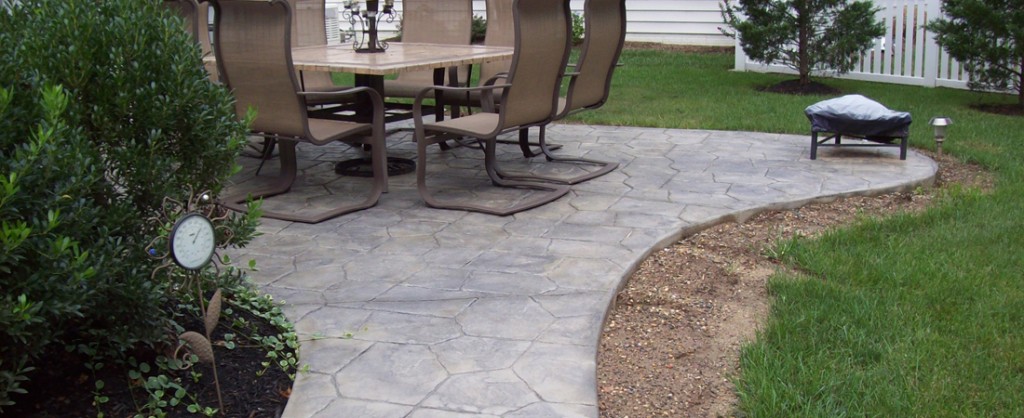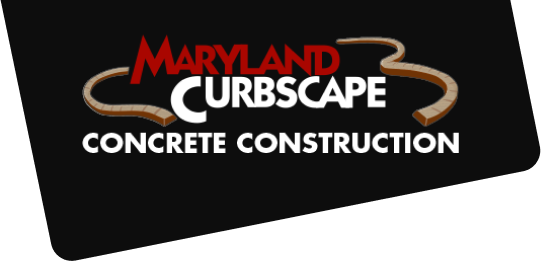Stamped concrete has emerged as a popular choice for homeowners and businesses alike, revolutionizing outdoor and indoor spaces with its exquisite aesthetics and exceptional durability. If you’ve ever been curious about this versatile decorative concrete solution, you’re in the right place! In this blog post, we’ll walk you through the most frequently asked questions about stamped concrete, shedding light on everything you need to know before considering it for your next project.

If you are a Maryland resident and ready to take the next step for your stamped concrete project, contact us and we can provide quotes and answer any questions you have.
1. What Exactly is Stamped Concrete?
At its core, stamped concrete is a decorative concrete surface that emulates the appearance of natural materials like stone, brick, slate, or wood. Through a meticulous process, unique patterns and textures are imprinted onto freshly poured concrete, creating a stunning visual effect.
2. Where Can Stamped Concrete Be Used?
Stamped concrete finds its place in a myriad of settings, both outdoor and indoor. Its versatility makes it an ideal choice for patios, pool decks, driveways, walkways, and courtyards. Indoors, you can explore its charm in basements, commercial spaces, and other areas where a decorative concrete floor is desired.
Here are some examples of places stamped concrete can be used.
3. How is Stamped Concrete Installed?
The installation of stamped concrete involves several crucial steps. First, the designated area is thoroughly cleaned and prepared. Fresh concrete is then poured, and either integral color or surface-applied color hardeners are added to achieve the desired hue. Next, stamps with selected patterns are pressed onto the concrete before it sets, imparting texture and depth to the surface. Finally, a protective sealer is applied, ensuring longevity and enhancing its appeal.
4. What Patterns and Designs Are Available?
Stamped concrete opens up a world of design possibilities. Among the popular patterns are Ashlar Slate, Herringbone Brick, Random Stone, Cobblestone, and Wood Plank, each offering unique charm and character. Moreover, custom patterns can be crafted to match individual preferences and complement specific architectural styles.
Explore some of the styles and designs with these real-life stamped concrete projects.
5. How Does Stamped Concrete Compare to Other Materials?
One of the significant advantages of stamped concrete lies in its cost-effectiveness. Compared to traditional materials like pavers or natural stone, stamped concrete offers a comparable aesthetic at a fraction of the cost. Additionally, it provides greater design flexibility, allowing you to achieve the look you desire without compromising on quality.
6. Is Stamped Concrete Durable?
Absolutely! When professionally installed and adequately maintained, stamped concrete boasts remarkable durability. It can endure heavy foot traffic and varying weather conditions, standing the test of time with proper care. Regular cleaning and periodic resealing are recommended to preserve its longevity and appearance.
7. How Long Does Stamped Concrete Last?
The lifespan of stamped concrete varies depending on several factors, including the quality of installation, maintenance, and environmental conditions. With attentive care, it can endure for several decades, making it a wise investment for homeowners and business owners alike.
8. Is Stamped Concrete Slippery When Wet?
Like any hard surface, stamped concrete can become slippery when wet. However, the extent of slipperiness largely depends on the texture of the chosen pattern. Some patterns offer a slightly textured surface, which can help improve traction. To enhance safety, it’s advisable to incorporate anti-slip measures, particularly in areas with frequent water exposure such as a pool deck.
9. Can Stamped Concrete Be Repaired?
Yes, stamped concrete can be repaired if it sustains damage or develops cracks over time. Minor cracks can be filled with concrete patching materials, while more significant issues may require professional intervention. Addressing any damage promptly can prevent it from worsening and ensure the longevity of the surface.
10. Can Stamped Concrete Be Customized?
Absolutely! Stamped concrete provides an extensive range of customization options. From selecting specific patterns and colors to combining multiple textures, you have the freedom to create a distinctive design that reflects your personal style and complements your surroundings.
11. Can Stamped Concrete Be Used in Cold Climates?
Yes, stamped concrete can be used in cold climates but it’s not recommended to pour concrete in extreme cold weather. Stamped concrete is best installed at temperatures above 40 degrees and when there is no chance of freezing temps. Proper installation and appropriate maintenance are crucial to ensuring the longevity of the stamped concrete. In regions experiencing freeze-thaw cycles, it’s essential to use concrete mixes and sealers suitable for such conditions. Regular sealing can also safeguard the surface from potential freeze-thaw damage.
12. Can Stamped Concrete Be Applied Over Existing Concrete?
Certainly! In many cases, stamped concrete can be applied over existing concrete surfaces, provided they are in good condition. The existing concrete should be thoroughly cleaned and examined for structural issues or cracks before applying the new stamped concrete overlay. In many cases, however, it is often best to tear up the old concrete before laying the new stamped concrete.
13. How Much Does Stamped Concrete Cost?
The cost of stamped concrete can vary based on several factors, including the chosen pattern, the size of the area, accessibility, and regional labor costs. Generally, stamped concrete is more affordable than natural stone or pavers while delivering comparable aesthetics. The average starting stamped concrete cost is nearly $17 – $18 / Sq. Foot depending on needs, while brick pavers and stone average over $20 / Sq. Foot.
14. Can I Install Stamped Concrete Myself?
While some DIY enthusiasts may consider installing stamped concrete themselves, it is a complex process that demands expertise, experience, and specialized equipment. To ensure the best results and avoid potential issues, it is highly recommended to hire a professional concrete contractor with expertise in stamped concrete.
Stamped concrete has transformed countless outdoor and indoor spaces, adding character and elegance wherever it is applied. From its breathtaking designs to its exceptional durability, it remains a top choice for those seeking beauty and functionality in its hardscape design. Whether you’re revitalizing your patio or dreaming up a new driveway, stamped concrete offers an affordable, low-maintenance solution that will leave a lasting impression.
If you have questions or need more information, make sure to contact a local stamped concrete contractor near you.
